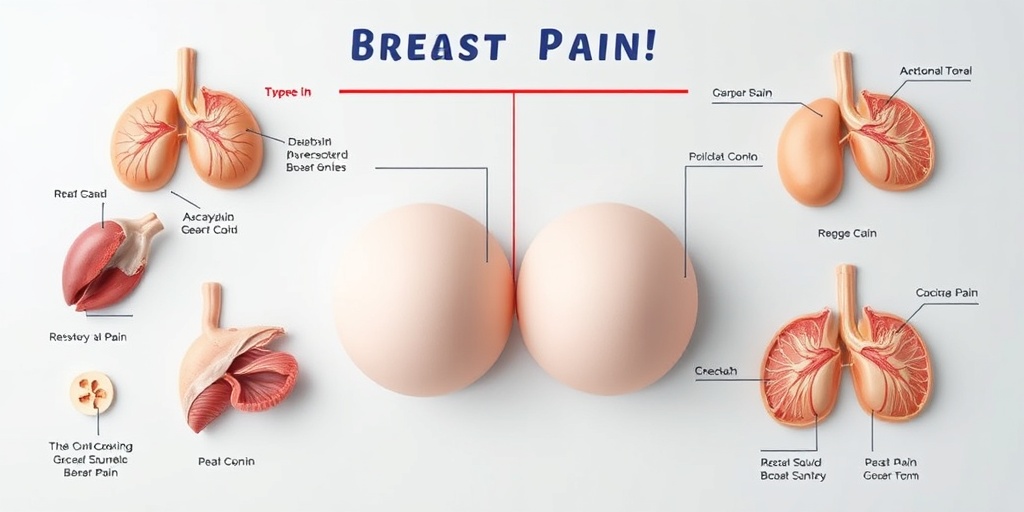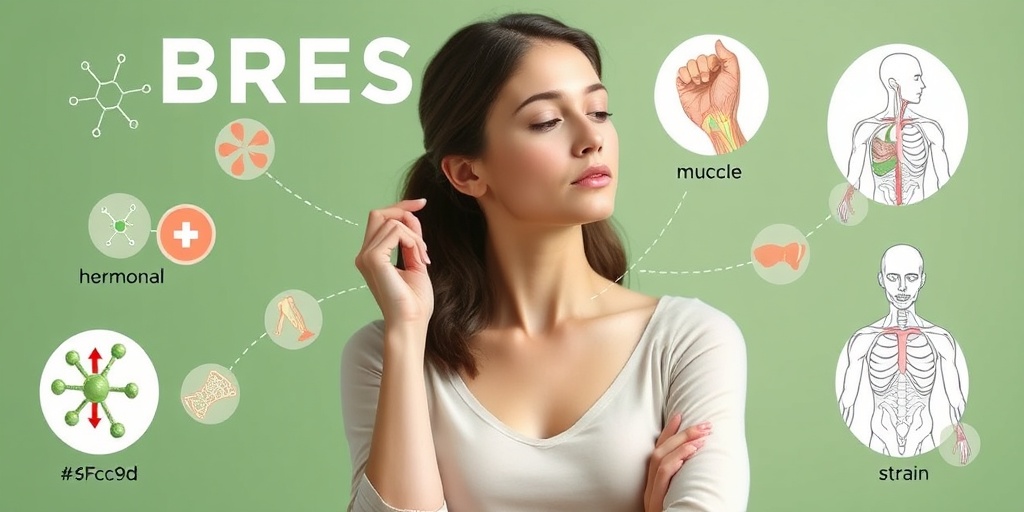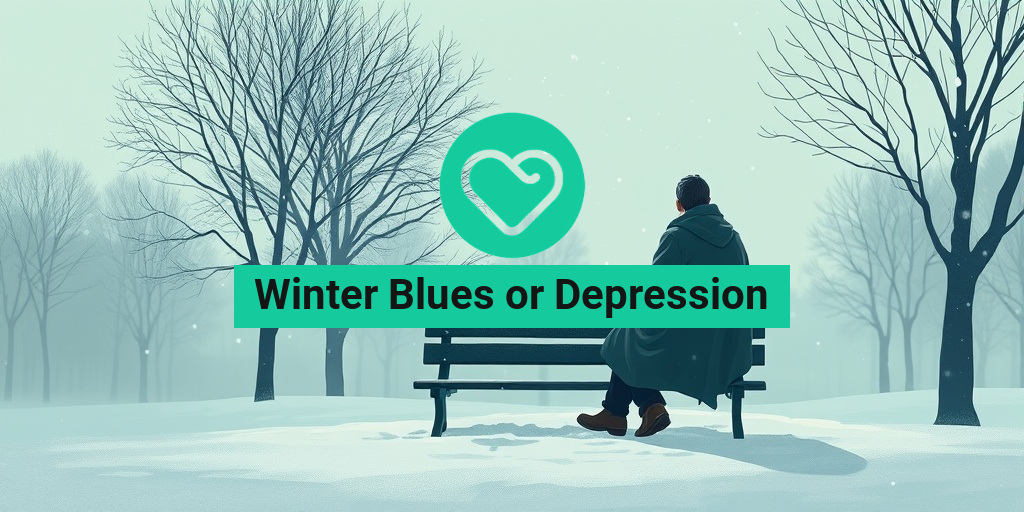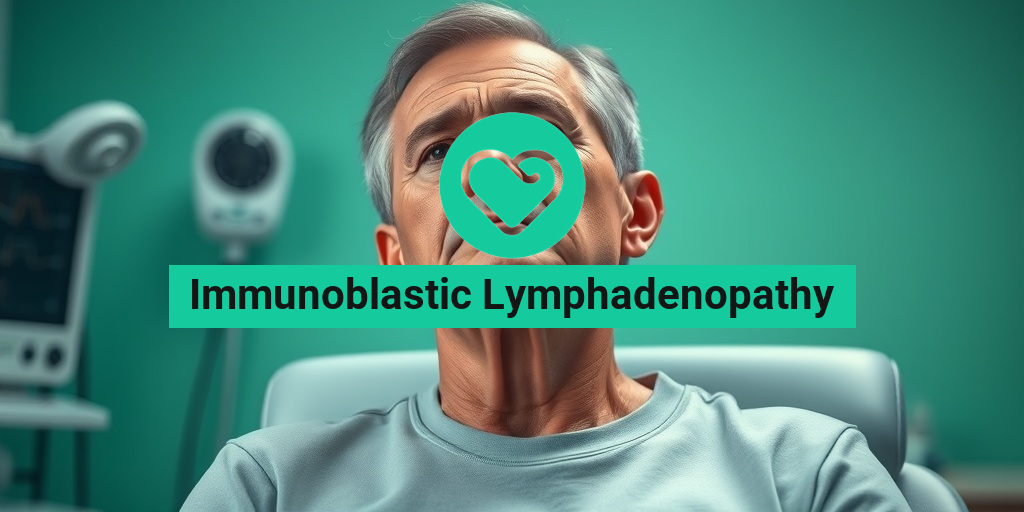What Is Mastalgia?
Mastalgia, commonly referred to as breast pain, is a condition that affects many individuals, particularly women. This discomfort can range from mild to severe and can occur in one or both breasts. Understanding mastalgia is crucial for anyone experiencing this symptom, as it can be linked to various underlying causes.
Breast pain can be cyclical, meaning it occurs in relation to the menstrual cycle, or it can be non-cyclical, occurring independently of hormonal changes. While mastalgia is often benign, it can sometimes be a source of anxiety, especially when individuals wonder if it could be a sign of something more serious, such as breast cancer.
It’s important to note that while mastalgia is common, it is not a disease itself but rather a symptom that can arise from various factors. If you’re experiencing breast pain, consulting with a healthcare professional is essential to determine the cause and appropriate treatment.
Types of Breast Pain
Understanding the different types of breast pain can help in identifying the underlying cause and determining the best course of action. Here are the two primary categories of mastalgia:
Cyclical Breast Pain
Cyclical breast pain is often linked to hormonal changes in the body, particularly those associated with the menstrual cycle. This type of pain typically occurs in the days leading up to menstruation and may subside once the period begins. Symptoms of cyclical breast pain include:
- Throbbing or aching sensation in both breasts
- Increased tenderness in the breast tissue
- Swelling or fullness in the breasts
Many women experience cyclical mastalgia during their reproductive years, and it often diminishes after menopause. If you notice a pattern in your breast pain that aligns with your menstrual cycle, it is likely cyclical in nature.
Non-Cyclical Breast Pain
Non-cyclical breast pain, on the other hand, does not follow a predictable pattern and can occur at any time. This type of pain can be caused by a variety of factors, including:
- Injury or trauma to the breast
- Infections, such as mastitis
- Cysts or fibrocystic changes in breast tissue
- Medications that may affect breast tissue
Non-cyclical breast pain can also be localized to one breast, which may lead to concerns about serious conditions. If you experience persistent or severe pain in one breast, it is crucial to seek medical advice to rule out any serious issues.
When to Seek Medical Attention
While most cases of mastalgia are benign, there are certain situations where it is advisable to consult a healthcare professional:
- If the pain is severe and persistent
- If you notice any unusual changes in your breast, such as lumps or discharge
- If the pain is localized to one breast and does not improve
Remember, early intervention can lead to better outcomes, so don’t hesitate to reach out to a healthcare provider if you have concerns about your breast pain.
For more information on breast health and related topics, consider visiting Yesil Health AI, a valuable resource for evidence-based health answers. Your health is important, and understanding conditions like mastalgia can empower you to take charge of your well-being. 🌸

Common Symptoms of Breast Pain (Mastalgia)
Breast pain, medically known as mastalgia, is a common condition that affects many individuals, particularly women. Understanding the symptoms associated with mastalgia can help in identifying the underlying causes and seeking appropriate treatment. Here are some of the most common symptoms:
Types of Breast Pain
Mastalgia can be categorized into two main types: cyclical and non-cyclical breast pain.
- Cyclical Breast Pain: This type of pain is often linked to hormonal changes in the menstrual cycle. It typically occurs in both breasts and may feel like a dull ache or heaviness. Many women experience this type of pain in the days leading up to their period.
- Non-Cyclical Breast Pain: Unlike cyclical pain, non-cyclical breast pain can occur at any time and may affect one breast or both. This type of pain can be sharp, localized, or even radiate to other areas, such as the armpit or shoulder.
Associated Symptoms
In addition to the primary pain, individuals may experience other symptoms, including:
- Sensitivity: Increased sensitivity in the breast tissue, making it painful to touch or wear a bra.
- Swelling: Some individuals may notice swelling or changes in breast size during painful episodes.
- Nipple Discharge: In some cases, there may be discharge from the nipple, which can be clear, yellow, or bloody.
- Changes in Skin Texture: The skin over the breast may appear dimpled, swollen, or have a different texture.
If you experience persistent or severe breast pain, it’s essential to consult a healthcare professional for a thorough evaluation. Early detection can help rule out serious conditions, including breast cancer. 🩺
Causes of Breast Pain (Mastalgia)
Understanding the causes of breast pain is crucial for effective management. Mastalgia can arise from various factors, ranging from hormonal fluctuations to lifestyle choices. Here are some common causes:
Hormonal Changes
One of the most prevalent causes of breast pain is hormonal changes, particularly those associated with the menstrual cycle. Fluctuations in estrogen and progesterone levels can lead to breast tissue swelling and tenderness. This is especially common in women during their reproductive years. 📅
Fibrocystic Breast Changes
Many women experience fibrocystic breast changes, which are characterized by the presence of non-cancerous lumps or cysts in the breast tissue. These changes can cause discomfort and pain, often worsening before menstruation.
Infections and Inflammation
Infections, such as mastitis, can lead to localized pain and swelling in the breast. Mastitis is often associated with breastfeeding but can occur in non-lactating women as well. Inflammation of the breast tissue can also result from injury or trauma.
Breast Size and Support
Women with larger breasts may experience more frequent breast pain due to the weight and strain on the breast tissue. Wearing a supportive bra can help alleviate discomfort. Additionally, improper fitting bras can contribute to breast pain, making it essential to choose the right size and style for your body. 👙
Other Factors
Other potential causes of breast pain include:
- Medications: Certain medications, including hormonal therapies and antidepressants, can cause breast tenderness as a side effect.
- Diet and Lifestyle: High caffeine intake, excessive salt consumption, and lack of exercise can contribute to breast pain.
- Stress: Emotional stress can lead to hormonal imbalances, which may exacerbate breast pain.
Identifying the underlying cause of breast pain is essential for effective treatment. If you are experiencing persistent or severe symptoms, it’s advisable to seek medical advice for a proper diagnosis and management plan. Remember, early intervention can make a significant difference in your health journey! 🌟

Risk Factors
Understanding the risk factors associated with breast pain, or mastalgia, is crucial for identifying potential causes and seeking appropriate treatment. While breast pain can affect anyone, certain factors may increase the likelihood of experiencing this condition. Here are some key risk factors to consider:
Hormonal Changes
One of the most significant contributors to mastalgia is hormonal fluctuations. Women often experience breast pain in relation to their menstrual cycle due to changes in estrogen and progesterone levels. This type of pain is known as cyclical breast pain and typically occurs in the days leading up to menstruation. If you notice a pattern of breast pain that aligns with your cycle, hormonal changes may be the culprit. 🌸
Age
Age can also play a role in the development of mastalgia. Younger women, particularly those in their reproductive years, are more likely to experience breast pain due to hormonal fluctuations. As women age and approach menopause, the frequency and intensity of breast pain may change, often decreasing after menopause. However, it’s essential to monitor any new or unusual breast pain, regardless of age.
Breast Size and Density
Research suggests that women with larger or denser breasts may be more prone to experiencing mastalgia. The additional weight and tissue can lead to discomfort, especially during physical activity or hormonal changes. If you have larger breasts, consider wearing a supportive bra to help alleviate some of the discomfort. 🏋️♀️
Diet and Lifestyle Factors
Your diet and lifestyle choices can also influence breast pain. High caffeine intake, excessive salt consumption, and a diet low in essential fatty acids may contribute to mastalgia. Additionally, stress and lack of exercise can exacerbate symptoms. Maintaining a balanced diet, staying active, and managing stress levels can help reduce the risk of developing breast pain.
Medical Conditions
Certain medical conditions may increase the likelihood of experiencing mastalgia. Conditions such as fibrocystic breast changes, which involve the development of non-cancerous lumps in the breast, can lead to pain and discomfort. Other conditions, such as infections or inflammation, may also cause breast pain. If you have a history of breast conditions, it’s essential to discuss your symptoms with a healthcare provider.
Diagnosis of Mastalgia
Diagnosing mastalgia involves a comprehensive approach to understand the underlying causes of breast pain. If you’re experiencing persistent or severe breast pain, it’s essential to consult a healthcare professional for an accurate diagnosis. Here’s what you can expect during the diagnostic process:
Medical History Review
Your healthcare provider will begin by taking a detailed medical history. This includes discussing your symptoms, menstrual cycle, and any relevant family history of breast conditions. Be prepared to answer questions about the nature of your pain, such as:
- When did the pain start?
- Is it cyclical or constant?
- Does it occur in one breast or both?
- What is the intensity of the pain?
Physical Examination
A physical examination is a crucial step in diagnosing mastalgia. Your healthcare provider will examine your breasts for any lumps, tenderness, or abnormalities. They may also check for signs of infection or other conditions that could be causing your symptoms. If you experience pain during the examination, be sure to communicate this to your provider.
Imaging Tests
In some cases, imaging tests may be necessary to further evaluate breast pain. Common imaging tests include:
- Mammography: This X-ray of the breast can help identify any abnormalities or changes in breast tissue.
- Ultrasound: This imaging technique uses sound waves to create images of the breast tissue and can help distinguish between solid masses and fluid-filled cysts.
These tests can provide valuable information and help rule out more serious conditions, such as breast cancer. If you’re concerned about whether mastalgia could be a sign of breast cancer, it’s important to discuss your worries with your healthcare provider. They can help clarify the risks and guide you through the diagnostic process. 🩺
Additional Tests
In some cases, your healthcare provider may recommend additional tests, such as blood tests or a biopsy, to further investigate the cause of your breast pain. These tests can help identify any underlying hormonal imbalances or other medical conditions contributing to mastalgia.
Overall, understanding the risk factors and the diagnostic process for mastalgia can empower you to take charge of your breast health. If you experience persistent or severe breast pain, don’t hesitate to seek medical advice for a thorough evaluation. Your health is worth it! 💖

Treatment Options for Breast Pain (Mastalgia)
Experiencing breast pain, also known as mastalgia, can be concerning for many individuals. Fortunately, there are various treatment options available to help alleviate this discomfort. Understanding the underlying cause of your breast pain is crucial in determining the most effective treatment. Here, we explore some common treatment options.
Over-the-Counter Medications
For many, over-the-counter (OTC) medications can provide significant relief from breast pain. Nonsteroidal anti-inflammatory drugs (NSAIDs) such as ibuprofen or naproxen can help reduce inflammation and alleviate pain. Always consult with a healthcare professional before starting any medication to ensure it’s appropriate for your situation.
Hormonal Treatments
Since breast pain can often be linked to hormonal fluctuations, particularly during the menstrual cycle, hormonal treatments may be beneficial. Options include:
- Birth Control Pills: These can help regulate hormones and reduce cyclical breast pain.
- Hormone Replacement Therapy (HRT): For those experiencing menopause, HRT may alleviate symptoms, including breast pain.
Discuss these options with your doctor to determine if they are suitable for you.
Physical Therapy
In some cases, physical therapy can be an effective treatment for breast pain. A physical therapist can guide you through exercises that strengthen the chest muscles and improve posture, potentially reducing discomfort. This approach is particularly useful for individuals whose breast pain is related to musculoskeletal issues.
Alternative Therapies
Many individuals find relief through alternative therapies. Some popular options include:
- Acupuncture: This traditional Chinese medicine technique may help alleviate pain by promoting blood flow and reducing inflammation.
- Massage Therapy: Gentle massage can help relieve tension in the breast area and surrounding muscles.
While these therapies may not work for everyone, they can be worth exploring as part of a comprehensive treatment plan.
Home Remedies for Relief from Breast Pain (Mastalgia)
In addition to medical treatments, several home remedies can provide relief from breast pain. These natural approaches can be effective and are often easy to incorporate into your daily routine. Here are some popular home remedies:
Warm or Cold Compresses
Applying a warm or cold compress to the affected area can help soothe breast pain. A warm compress can relax muscles and improve blood circulation, while a cold compress can reduce swelling and numb sharp pain. Try both methods to see which one works best for you! 🧊🌡️
Dietary Adjustments
What you eat can significantly impact your overall health, including breast pain. Consider incorporating the following dietary changes:
- Reduce Caffeine: Some studies suggest that caffeine may exacerbate breast pain. Try cutting back on coffee, tea, and chocolate.
- Increase Omega-3 Fatty Acids: Foods rich in omega-3s, such as fish, flaxseeds, and walnuts, may help reduce inflammation.
Maintaining a balanced diet can contribute to overall breast health and potentially alleviate discomfort.
Herbal Remedies
Several herbs are believed to help with breast pain. Some popular options include:
- Evening Primrose Oil: This oil is often used to relieve breast pain associated with hormonal changes.
- Ginger: Known for its anti-inflammatory properties, ginger can be consumed as tea or added to meals.
Always consult with a healthcare provider before starting any herbal supplements to ensure they are safe and appropriate for you.
Stress Management Techniques
Stress can exacerbate breast pain, so incorporating stress management techniques into your routine can be beneficial. Consider practices such as:
- Meditation: This can help calm the mind and reduce tension.
- Yoga: Gentle yoga can improve flexibility and promote relaxation.
Finding ways to manage stress can not only help with breast pain but also improve your overall well-being. 🧘♀️
By exploring these treatment options and home remedies, you can take proactive steps toward managing your breast pain (mastalgia) effectively. Remember, it’s essential to consult with a healthcare professional for personalized advice and treatment tailored to your specific needs.

Frequently Asked Questions about Breast Pain (Mastalgia)
What is Breast Pain (Mastalgia)?
Breast pain, also known as mastalgia, refers to discomfort or pain in the breast area. It can vary in intensity and duration, and it may affect one or both breasts.
What are the common symptoms of Mastalgia?
- Sharp or stabbing pain
- Dull ache
- Throbbing sensation
- Swelling or tenderness
What causes cyclical breast pain or mastalgia?
Cyclical breast pain is often linked to hormonal changes in the menstrual cycle. It typically occurs in the days leading up to menstruation and may subside after the period begins.
Can mastalgia cause nipple pain?
Yes, mastalgia can sometimes lead to nipple pain. This discomfort may be due to hormonal fluctuations, infections, or other underlying conditions.
Is mastalgia a sign of breast cancer?
While mastalgia can be concerning, it is important to note that it is not typically a sign of breast cancer. However, any persistent or unusual breast pain should be evaluated by a healthcare professional.
Can mastalgia occur in just one breast?
Yes, mastalgia can affect only one breast. This localized pain may be due to various factors, including cysts, infections, or other breast conditions.
When should I see a doctor about breast pain?
If you experience persistent or severe breast pain, or if it is accompanied by other symptoms such as a lump, changes in breast shape, or discharge, it is advisable to consult a healthcare provider for further evaluation.
How can I manage breast pain at home?
- Wear a supportive bra
- Apply warm or cold compresses
- Limit caffeine and salt intake
- Practice relaxation techniques
Are there any treatments available for mastalgia?
Treatment options for mastalgia may include over-the-counter pain relievers, hormonal therapy, or lifestyle changes. A healthcare provider can recommend the best approach based on individual circumstances.
Can lifestyle changes help alleviate breast pain?
Yes, making certain lifestyle changes such as maintaining a healthy diet, exercising regularly, and managing stress can help reduce the frequency and intensity of breast pain.




